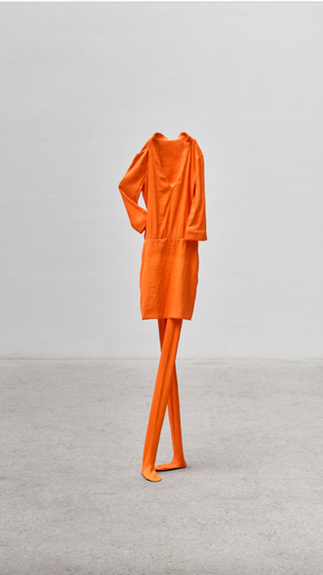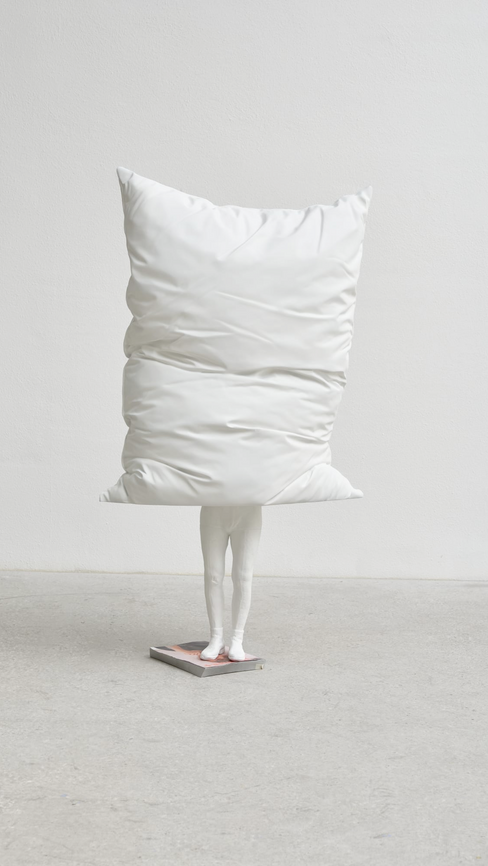ERWIN WURM'S 'SURROGATES' AT THADDAEUS ROPAC
- Luke Ray
- Feb 22, 2024
- 4 min read
Surrogates is Erwin Wurm's latest exhibition at Thaddaeus Ropac’s London gallery. Wurm’s work is often defined as a sculptural probe into the absurd and paradoxical reality of daily life. This show’s assembled sculptures induce a humour that, of his work, Wurm wontedly insists is unintended. And yet, the odd chuckle persists to sound about the space. Why does Wurm’s work consistently elicit this response? It can likely be chalked down to a recognition of the artist’s locus: the absurd. Through it, Wurm successfully incites the eye to alight on quotidian matters in new and foreign ways.
From left to right: Erwin Wurm, Ghosts (Subsitutes) (2022), Walking (Subsitutes) (2024), Orange Step Small (Substitutes) (2024). Images courtesy of Thaddaeus Ropac.
The overarching target of Surrogates seems ostensively to be clothes. They are, according to Wurm, our ‘second skin’. We don them as a form of voluminous makeup. In the myriad series Substitutes, Wurm razes and casts this metaphoric flab as brightly-painted metal, formalising the viewer’s contemplation of the subject. The nine disembodied sculptures range from diminutive to ginormous. On the ground floor we encounter Walking Small (Substitutes) (2024), a metre high, its aluminium painted white. Then, again, on the first floor, we encounter Walking (Substitutes) (2024), the same figure, twice the size, in patinated bronze. Breeze (2022) is another of these doubled figures. The same logic applies to it. We may look upon these repeated figures as indicative of some Platonic ideal, or perhaps more simply the artist’s own. Orange Step Small (Substitutes) (2024) is perched alone on a staircase niche. The petite contrapposto figure recalls the outmoded Go-Go fashions of the Swinging Sixties. Wurm’s knack for the absurd invites us to observe these outfits in a sober light. In this instance, removed from the bewildering influence of any wearer, we see the dress with clarity: as a domesticated product, scaled-down to fit within the bounds of the TV.
Balzac (After Rodin) (2023) is a postmodern redressing of Rodin’s vaunted Monument to Balzac (1897). Wurm drapes Balzac’s figure in baseball caps and designer bags. Neither this, nor Repentance (After Donatello) (2023) were conceived with Surrogates in mind. Still, they achieve that same effect as Orange Step Small (Substitutes) (2024), which is to tease out the absurdity of an outfit. By absenting the human body from his sculptures, Wurm makes tenable the figures’ interchangeability. In the library gallery of Thaddeus Ropac, overlooked by the hulking Ghost (2022) and Breeze (2022), the viewer becomes an active participant in a series of One Minute Sculptures. Despite Wurm beginning One Minute Sculptures almost thirty years ago, their effect on his audience remains potent. Obey (One Minute Sculptures) (2023) implores us to defer ourselves to a broomstick set between our head and a nondescript stump into which the instrument is rested. We bow to the same authority we tout in Be The Police (One Minute Sculptures) (2024), in which we are made to stand erect and wear an Austrian police cap; in short, to be the police. This is in service of demystification. There is, for Wurm, no such thing as hierarchy. There are only representations, symbols, signification and - oddly enough - clothing.
Exhibited in Surrogates are three Mind Bubbles, comprising a new series for Wurm. Each sculpture forms a pair of adamantine legs, clownish shoes and a bulbous, quite literally petrified upper-half. Pursuing similar visual cues is another of Wurm’s new series: Dreamers. In it, bodies are whited, portioned and engulfed by bulging pillows. In Dreamer (2024), a vertical pillow surmounts a small pair of legs. In Dreamer, One Arm (2024), a horizontal pillow tops an arm. These are sculptural embodiments of sentiments; self-visualisations of a mordant sort. Dreamer calls upon our unconscious sense of what it means to dream, to feel present in body and absent in mind. Mind Bubbles appeals to that inverse sense of being overly present in mind to the point at which it overwhelms our person.
From left to right: Erwin Wurm, Dreamer (2023) and Mind Bubble Walking Pink (2024). Images courtesy of Thaddaeus Ropac.
Wurm’s materialisations of psychology continue into his Paradise series. Paradise I (Idea of a High Heel Big) (2024) is a vision of adiposity, much akin to his celebrated ‘Fat’ sculptures. Paradise II (Idea of a High Heel) (2024) resembles a toddler’s attempt to sketch a high heel from memory. Indeed, the title seems to clarify a lack of reference material and a consequent reliance on idea. There is, through this, something deeply human. We possess the innate capability to visualise objects, but we cannot eliminate our margin for formal error. We also possess the innate capability to dwarf or boost objects to inordinate proportions, but we could never do so in reality. Wurm, however, does so in an absurd turn of form, from the mental to the sculptural. It is this sublimation throughout Wurm’s work which tempts us to see the world anew.
From left to right: Erwin Wurm, Paradise I (Idea of a High Heel) (2024) and Paradise I (Idea of a High Heel) (2024). Images courtesy of Thaddaeus Ropac.
Luke Ray is a writer based in London.


















